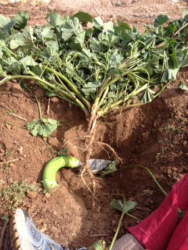Mallow, Persistence, and Learning
it's all connected
It sometimes strikes me as so backward that I learned most of what I know about herbs from reading books and looking at them captured in jars in stores. Going out "in the wild" and getting to know the herb and making a relationship with them would be "better," in my judgment.
Then again, most of our learning is secondhand, isn't it? I give thanks for all the teachers and books who share portals into knowledge, leave threads that we can pick up and follow through the maze to find our own experiences.
I was also the little girl who made potions from herbs in the back yard, so experiential learning has always been there.
I'll be talking about herbs often here, both for what they teach and offer, and for the metaphorical lessons.
Perhaps it's because I've been thinking about Mastery lately, but yesterday a mallow taught me about persistence.
Mallow, malva parviflora (which means "little-flowered mallow") is an old favorite. Soft, furry, round leaves are soothing on the digestion and pleasant tasting, far less bitter than many wild greens. Those little compact flowers look like liliputian cheesewheels, and my "Flower Fairy" book had the mallow as "fairy cheese." "Cheesewheel" is one of its common names in English, and in Hebrew it's called "Arab cheese."
I should note that the comparison with cheese is purely visual. I loathe cheese more than almost any other food and even have trouble with the word; thankfully the mallow flowers taste tart and slightly nutty and green.
But I digress. Mallow was used as food and medicine in the ancient Mediterranean, and it grows just about everywhere (I've seen it from Alaska to Arizona!) -- in other words, it's hardy and adaptable.
I've generally eaten just the leaves and flowers. For the most part, taking the root, which means taking the whole plant, requires more justification and the right situation. Mallow root is valuable, though. It's one of those plants with mucilaginous carbohydrates that soothe the guts (demulcents). I've written about slippery elm on my old blog (and here too, briefly) as another one I find beneficial. Before high-fructose corn syrup and gelatin, that gelling property was how marshmallows were created!
In the right situation, I'd rather get my own mallow root than buy it at the herbal store, or buy slippery elm which is endangered. Yesterday, at the community garden, came the right situation. The mallow pictured was gigantic (trowel in the hole for scale, and you can see my whole lower leg, knee to sneaker, at the bottom edge). It was emphatically a weed in this context, and someone needed to pull it out.
I was excited to do it! Although my engagement with the plant was to its eradication, I knew I would be treating it with respect, giving it a new life in my body, and as mulch around my other plants. But, this was also right at the edge of when I needed to go home, so there was a temptation to yank it out, cut the root, take shortcuts.
My fingers teasing out the side roots from the thick dirt, my lower back warning me when I tried to pull too hard, the huge plume of leaves gradually wilting, all reminded me to stay present with the plant. To be aware of what I was doing in that moment, rather than running off into my schedule for the next hour. To follow the roots through the paths they had made patiently and carefully, dig broader and deeper, rather than just hacking it out.
Be present; be persistent; do it right. Three things both books titled Mastery emphasize as important. As well as, be specific in how you conceptualize what you're doing. Was I yanking out a big old weed, or was I harvesting medicine?
Either one might be true, but what I call it is crucial to what it is.
About the Author
Ela Harrison
Ela is a wordsmith and herb lover who has lived in many places and currently resides in Tucson, AZ.
